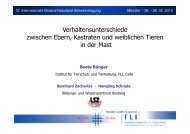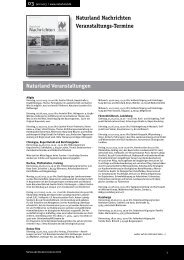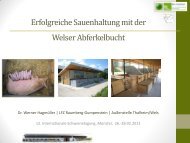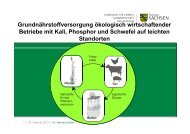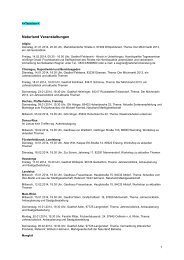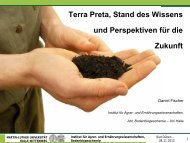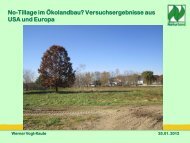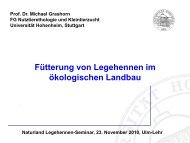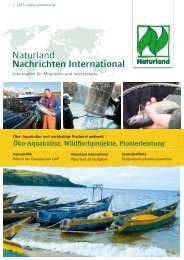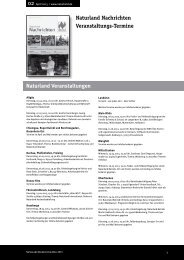Organic Farming in the Tropics and Subtropics: Peanuts - Naturland
Organic Farming in the Tropics and Subtropics: Peanuts - Naturland
Organic Farming in the Tropics and Subtropics: Peanuts - Naturland
Create successful ePaper yourself
Turn your PDF publications into a flip-book with our unique Google optimized e-Paper software.
II Special section: <strong>Organic</strong> Peanut Cultivation<br />
2. Aspects of plant cultivation<br />
2.1. Site requirements<br />
The peanut is very adaptable, <strong>and</strong> is cultivated <strong>in</strong> cont<strong>in</strong>ental areas with hot<br />
summers from <strong>the</strong> 45° nor<strong>the</strong>rn to <strong>the</strong> 40° sou<strong>the</strong>rn latitude.<br />
2.1.1. Climatic requirements<br />
Temperature<br />
The rate of growth <strong>and</strong> vegetation period of <strong>the</strong> peanut are highly <strong>in</strong>fluenced by<br />
temperature. 30-34°C is optimum for germ<strong>in</strong>ation (max. 45°C, m<strong>in</strong>. 15°C). Under<br />
20°C, <strong>the</strong> capacity to germ<strong>in</strong>ate, <strong>the</strong> rate of growth <strong>and</strong> development are rapidly<br />
reduced, <strong>and</strong> at around 14°C <strong>the</strong>y cease altoge<strong>the</strong>r. 25-30°C is optimum for<br />
vegetative growth. Temperatures above 34°C can damage <strong>the</strong> flower formation. The<br />
optimum temperature <strong>in</strong>fluences <strong>the</strong> net rate of photosyn<strong>the</strong>sis, <strong>the</strong> flower formation<br />
<strong>and</strong> <strong>the</strong> growth of <strong>the</strong> pods, <strong>and</strong> is <strong>the</strong>refore responsible for <strong>the</strong> greater yields<br />
outside <strong>the</strong> hot tropics 3 . Night-time temperatures should not s<strong>in</strong>k below 10°C dur<strong>in</strong>g<br />
<strong>the</strong> fructification process. Frost will always kill off <strong>the</strong> plant.<br />
Light<br />
The peanut can tolerate shade, it poses no problems when cultivated with trees or<br />
with o<strong>the</strong>r, mixed crops. When placed <strong>in</strong> shade, <strong>the</strong> leaves get bigger, <strong>and</strong> <strong>the</strong><br />
number of reproductive organs lessens (<strong>the</strong>re are too many of <strong>the</strong>se anyway),<br />
mean<strong>in</strong>g that <strong>the</strong> yield will only be reduced if <strong>the</strong> plant is subjected to extremely<br />
shady conditions. When <strong>the</strong> light is very <strong>in</strong>tense, <strong>the</strong> peanut (a C3-plant) achieves a<br />
comparable level of photosyn<strong>the</strong>sis as C4-plants. Arachis hypogaea is <strong>in</strong> a<br />
photoperiodic sense, practically neutral, although photoperiodic sensitive <strong>and</strong><br />
<strong>in</strong>sensitive varieties also exist.<br />
Water<br />
The optimum time to sow, which corresponds <strong>in</strong> many places with <strong>the</strong> ra<strong>in</strong>y season,<br />
depends largely on <strong>the</strong> ra<strong>in</strong>, as <strong>the</strong> yield s<strong>in</strong>ks rapidly when <strong>the</strong> plants are sown<br />
outside <strong>the</strong> optimum plant<strong>in</strong>g time. The germ<strong>in</strong>ation process requires enough air <strong>in</strong><br />
<strong>the</strong> soil. A grown peanut plant can tolerate flood<strong>in</strong>g conditions for up to a week,<br />
provid<strong>in</strong>g <strong>the</strong> water <strong>the</strong>n flows away completely without leav<strong>in</strong>g beh<strong>in</strong>d any stagnant<br />
pools 4 . In case of regular heavy rea<strong>in</strong> fall dur<strong>in</strong>g <strong>the</strong> vegetation period, <strong>the</strong> ground<br />
must be well dra<strong>in</strong>ed, or <strong>the</strong> peanuts planted on ridges.<br />
Peanut is more resistant to drought than cotton, yet less so than sorgo. Nitrogen<br />
fix<strong>in</strong>g can be <strong>in</strong>fluenced by drought.<br />
2 SAVAGE, G. P. <strong>and</strong> KEENAN, J. I. (1994): The composition <strong>and</strong> nutritive value of groundnut kernels. In:<br />
SMARTT, J.: The groundnut crop. Chapman & Hall, London.<br />
3 FRANKE, G. (1994): Nutzpflanzen der Tropen <strong>and</strong> Subtropen, Bd.3, Ulmer, Stuttgart.<br />
4 WEISS, E. A. (1983): Tropical oilseed crops. Longman, London.<br />
Naturl<strong>and</strong> e.V. – 1 st edition 2000 page 3




